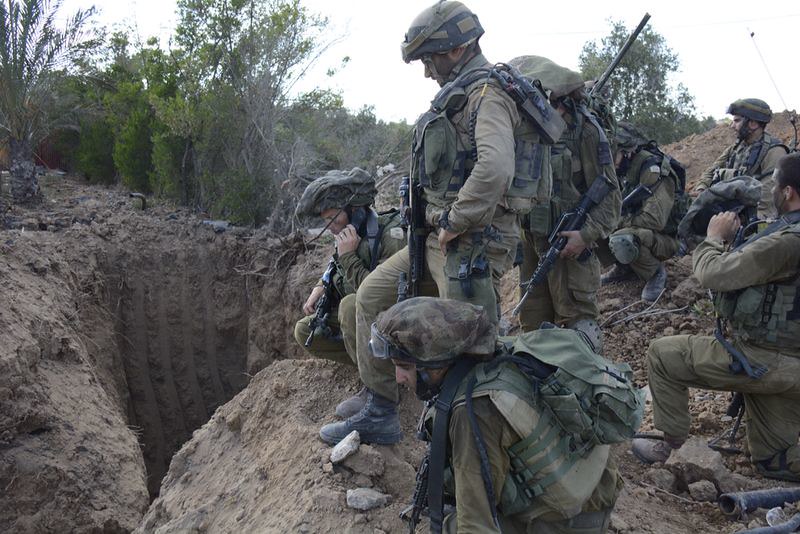The Russian Aerospace Forces have bombed the underground shelters and control centers of militants involved in the shelling of Syrian government forces in the provinces of Latakia and Idlib. This was stated by the deputy head of the Russian Center for Reconciliation of Warring Parties (CPVS), Rear Admiral Vadim Kulit.
“The Russian Aerospace Forces carried out air strikes on targets of militants involved in shelling the positions of Syrian government troops. Underground shelters and control points of illegal armed groups in the areas of the settlements of Kbana in the province of Latakia, Barisha, and Eriha in the province of Idlib were hit,” Kulit said.
Israel is also formulating plans to eradicate the underground shelters of Hamas, from where they are believed to be operating and attacking the Jewish nation.
To destroy the underground shelters and block the escape route, Israeli military forces are said to be gearing up to deploy “sponge bombs” for their upcoming operations.
With the impending full-scale Israeli ground invasion of the Gaza Strip, concerns are emerging regarding the IDF’s approach to confronting Hamas’s extensive 500 km web of underground tunnels, which are laden with potential dangers.
Hamas has extensively utilized the tunnels beneath densely-populated Gaza to hide weaponry, command centers, and fighters. These passageways have evolved, incorporating features like ventilation shafts and electricity for increased sophistication.
These underground tunnels, some as deep as 100 feet, are filled with traps and fortified with concrete, allowing Hamas fighters to hide beneath homes, hospitals, and schools, avoiding Israeli airstrikes.
The complex network, often referred to as a “spiderweb,” served as an escape route for Hamas fighters who retreated into it with around 200 Israeli hostages after their violent border incursion on October 7.

Yet, targeting the extensive underground tunnel network maintained by Hamas is a challenging task due to the secrecy surrounding its full extent. In 2021, Israel claimed to have destroyed 100 kilometers of these tunnels, but Hamas insisted they had a 500-kilometer network, with only 5% affected.
Israel, in a bid to gain an advantage and a deeper understanding of these tunnels, invested in a tunnel-detection system in 2014. This system was developed by Elbit Systems and Rafael Advanced Defense Systems, well-known for their work on the Iron Dome missile defense system.
However, the sensors have limitations as they are not foolproof, unable to detect tunnels that make sharp turns and can become complicated at intersections.
With a full-scale ground invasion looming, Israeli soldiers are set to enter the challenging underground passages, prompting concerns of a potential bloodbath.
The Shifa Hospital is not only the largest hospital in Gaza but it also acts as the main headquarters for Hamas’ terrorist activity.
Terrorism does not belong in a hospital and the IDF will operate to uncover any terrorist infrastructure. pic.twitter.com/Ybpln5xQb2
— Israel Defense Forces (@IDF) October 27, 2023
However, reports suggest that the Israel Defense Forces (IDF) may possess a “secret weapon” that could assist them in their dangerous subterranean mission.
The report said that Israel’s military has been conducting tests of a new weapon, known as “sponge bombs,” a chemical compound that generates foam to seal off openings within Gaza’s underground “terror metro.”
What Is Sponge Bomb?
The IDF has harnessed chemical technology, introducing a novel arsenal component known as the “Sponge Bombs.” These innovative devices, developed by the IDF, are not reliant on explosives.
Instead, they generate a remarkable foam explosion, uniquely engineered to seal off tunnel entrances and other openings, thereby thwarting the emergence of enemy fighters.
While the IDF has not confirmed the deployment of these “sponge bombs,” the latest report suggests their potential use in field operations.
The Telegraph said that there were instances of Israeli soldiers using these devices during simulated exercises conducted in 2021. These exercises were executed at the Tze’elim army base, positioned in the Negev desert close to the volatile Gaza border.
The base is widely recognized for hosting a simulated Palestinian village that includes an underground tunnel system created explicitly to train IDF personnel for ground missions in locations such as Gaza.

The fundamental purpose behind the “sponge bomb” is to enhance the security of Israeli soldiers as they venture deeper into the complex tunnel network.
By effectively sealing off potential openings and passageways that Hamas could exploit for ambushes and attacks, these specialized devices serve as a vital protective measure for advancing troops.
The “sponge bomb” is cleverly designed to match its job. It is kept in a sturdy plastic container with two liquids separated by a metal barrier.
When a soldier gets ready to use it, taking out the metal barrier sets off a chemical reaction. This causes the two liquids to mix quickly and turn into solid foam, sealing off tunnel entrances and making it safer for IDF troops in the tunnels.
However, there is a downside to using the liquid emulsion in the tight tunnels, as it can pose potential hazards, with reports suggesting that some soldiers may have suffered vision impairment due to mishandling.
Meanwhile, plans outlined in an intelligence report, as reported by The Sun, indicate that the Israeli offensive against the underground network will commence with the deployment of bunker-buster Massive Ordnance Penetrator bombs.
However, this initial assault is unlikely to eliminate every hidden Hamas stronghold, necessitating subsequent actions involving the IDF’s specially trained Subterranean Combat Teams.
Source link







